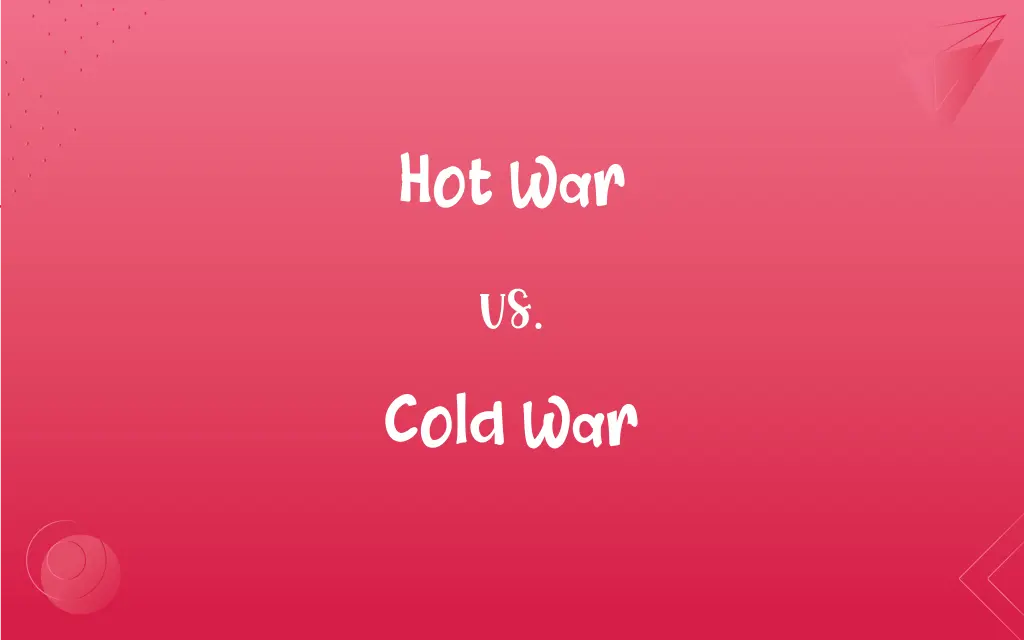Hot War vs. Cold War: What's the Difference?
Edited by Aimie Carlson || By Harlon Moss || Updated on October 6, 2023
A hot war involves direct military conflict, while a cold war is characterized by political tension and proxy wars without full-scale combat between the main opposing powers.

Key Differences
A hot war denotes a situation where two or more nations are actively engaged in direct combat scenarios. This term implies that there's actual, tangible conflict taking place. On the other hand, a cold war represents a period of intense political and military rivalry without actual warfare between the major powers, but may involve proxy wars.
In a hot war, the involved nations' military forces confront each other on battlefields, leading to casualties, economic strain, and significant geopolitical consequences. In contrast, during a cold war, the main adversaries don't directly engage in open warfare. Instead, they might fund opposing sides in third-party conflicts or engage in espionage.
One of the most striking features of a hot war is the visibility of conflict. The damages—both to infrastructure and human lives—are apparent and immediate. A cold war, however, tends to be more insidious. The tension and rivalry might last for decades, influencing global politics and leading to arms races.
When countries are in a hot war, alliances might shift rapidly based on the immediate needs and dangers of warfare. But in a cold war, alliances often solidify based on ideological lines, as was seen with NATO and the Warsaw Pact during the Cold War era.
Notably, the aftermath of a hot war can be immediately quantifiable in terms of loss of life, territorial changes, and economic impact. However, the ramifications of a cold war, while extensive, may be more subtle, influencing cultural, technological, and political developments over a more extended period.
ADVERTISEMENT
Comparison Chart
Nature of Conflict
Direct military engagement.
Political and military rivalry without direct engagement.
Casualties
Directly results in casualties.
Casualties mainly in proxy wars, not between main powers.
Duration
Can be short-term or prolonged.
Often extended, spanning decades.
Global Impact
Immediate geopolitical consequences.
Extended influence on global politics and alliances.
Visibility
Clear, tangible conflict and damages.
Subtle, often involving espionage and proxy conflicts.
ADVERTISEMENT
Hot War and Cold War Definitions
Hot War
An ongoing state of warfare between nations.
Diplomatic efforts were made to prevent the crisis from turning into a hot war.
Cold War
A state of political hostility without open warfare.
The rivalry between the USA and the USSR escalated into a cold war post-World War II.
Hot War
War involving open and declared armed combat.
Historians often analyze the causes and consequences of hot wars to learn from past mistakes.
Cold War
Period of tension and competition without direct combat.
The cold war influenced global politics and alliances for several decades.
Hot War
A state of actual armed hostilities between nations.
World War II was a hot war that involved most of the world's major powers.
Cold War
A prolonged period of geopolitical tension without hot war.
The cold war led to significant advancements in technology due to the space race.
Hot War
Direct military conflict leading to casualties.
The skirmish escalated into a hot war, resulting in significant losses.
Cold War
Intense rivalry involving espionage and proxy wars.
The cold war era was marked by numerous proxy conflicts in Asia, Africa, and Latin America.
Hot War
A visible, active state of conflict.
The tensions at the border quickly transformed into a hot war, with both sides suffering.
Cold War
Hostilities marked by propaganda, threats, and other non-combative means.
The cold war was not just about military rivalry; it also encompassed cultural and ideological battles.
FAQs
Can a cold war escalate into a hot war?
Yes, if tensions rise significantly, a cold war can escalate into direct conflict or a hot war.
What primarily differentiates a hot war from a cold war?
A hot war involves direct combat, while a cold war is political tension without full-scale warfare between main opponents.
Which term describes the post-WWII tension between the USA and USSR?
This period is commonly referred to as the Cold War.
Are casualties more common in a hot war or a cold war?
Direct casualties are more common in a hot war due to open warfare.
Is the term hot war used for modern conflicts?
"Hot war" can describe any direct military conflict, whether historical or modern.
Was the Vietnam War part of the Cold War?
Yes, the Vietnam War was a proxy war during the Cold War era, with the USA and USSR supporting opposing sides.
Which war involves more espionage activities?
Espionage is typically more associated with cold wars, though it can occur in hot wars as well.
Is a cold war strictly between two countries?
While often between two major powers, a cold war can involve multiple nations aligned in opposing blocs.
Can economic battles be a feature of a cold war?
Yes, economic sanctions and competitions can be elements of a cold war.
Were nuclear weapons a significant concern during the Cold War?
Yes, the nuclear arms race and the threat of nuclear warfare were central concerns during the Cold War.
Can a country be neutral during a cold war?
Yes, several countries maintained a neutral stance during the Cold War, not aligning with either major bloc.
Can a hot war involve multiple countries?
Absolutely, a hot war can involve multiple countries, either as direct combatants or allies.
Do hot wars always result from cold wars?
Not necessarily; while a cold war can escalate into a hot war, many cold wars don't lead to direct combat.
Were there any peace talks during the Cold War?
Yes, several negotiations and treaties, like the SALT treaties, aimed to reduce tensions during the Cold War.
Can cultural and technological competitions be aspects of a cold war?
Yes, the space race and cultural exchanges during the Cold War between the USA and USSR are examples of this.
Were there any hot wars during the Cold War era?
Yes, there were several proxy wars during the Cold War, such as the Korean War and the Vietnam War.
Does a hot war always involve large-scale battles?
No, a hot war can involve smaller skirmishes, guerilla warfare, or large-scale battles.
Are cold wars solely a 20th-century phenomenon?
While the term became popular during the 20th century, periods of political tension without direct warfare have existed throughout history.
Is propaganda a feature of both hot and cold wars?
Yes, propaganda can be used in both types of wars to influence public opinion and morale.
Are hot wars shorter in duration than cold wars?
Not necessarily; while some hot wars are brief, others can last years, and cold wars can span decades.
About Author
Written by
Harlon MossHarlon is a seasoned quality moderator and accomplished content writer for Difference Wiki. An alumnus of the prestigious University of California, he earned his degree in Computer Science. Leveraging his academic background, Harlon brings a meticulous and informed perspective to his work, ensuring content accuracy and excellence.
Edited by
Aimie CarlsonAimie Carlson, holding a master's degree in English literature, is a fervent English language enthusiast. She lends her writing talents to Difference Wiki, a prominent website that specializes in comparisons, offering readers insightful analyses that both captivate and inform.
































































